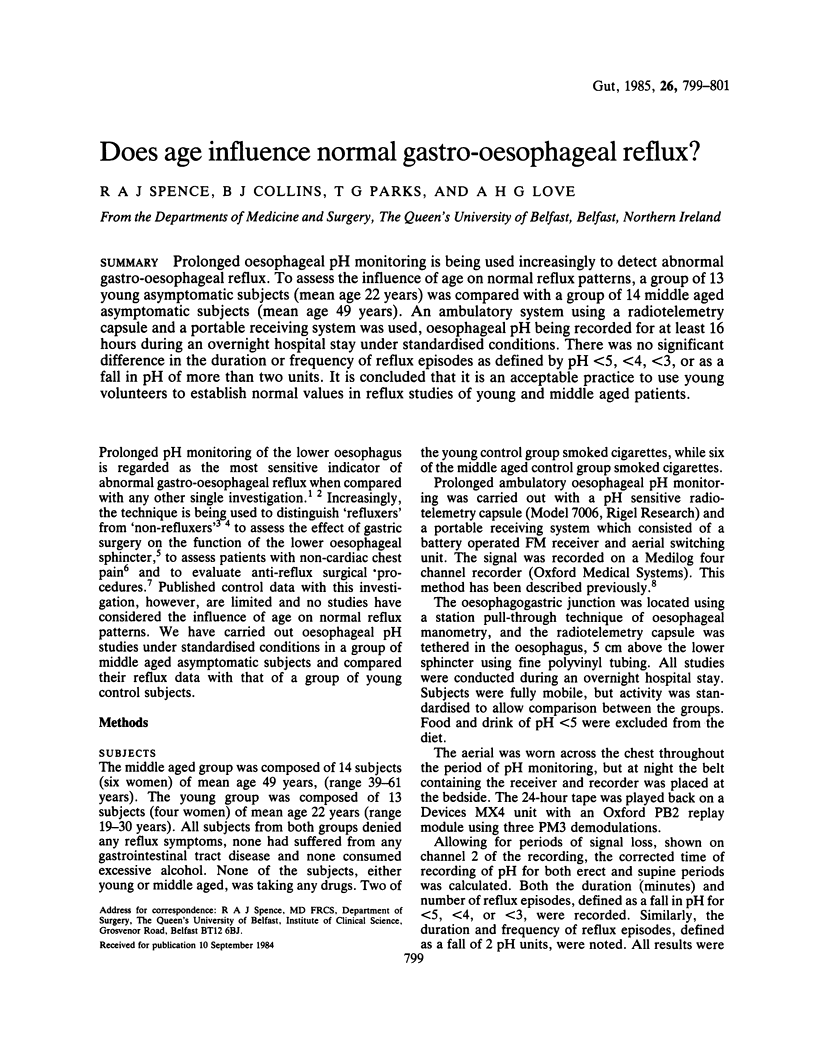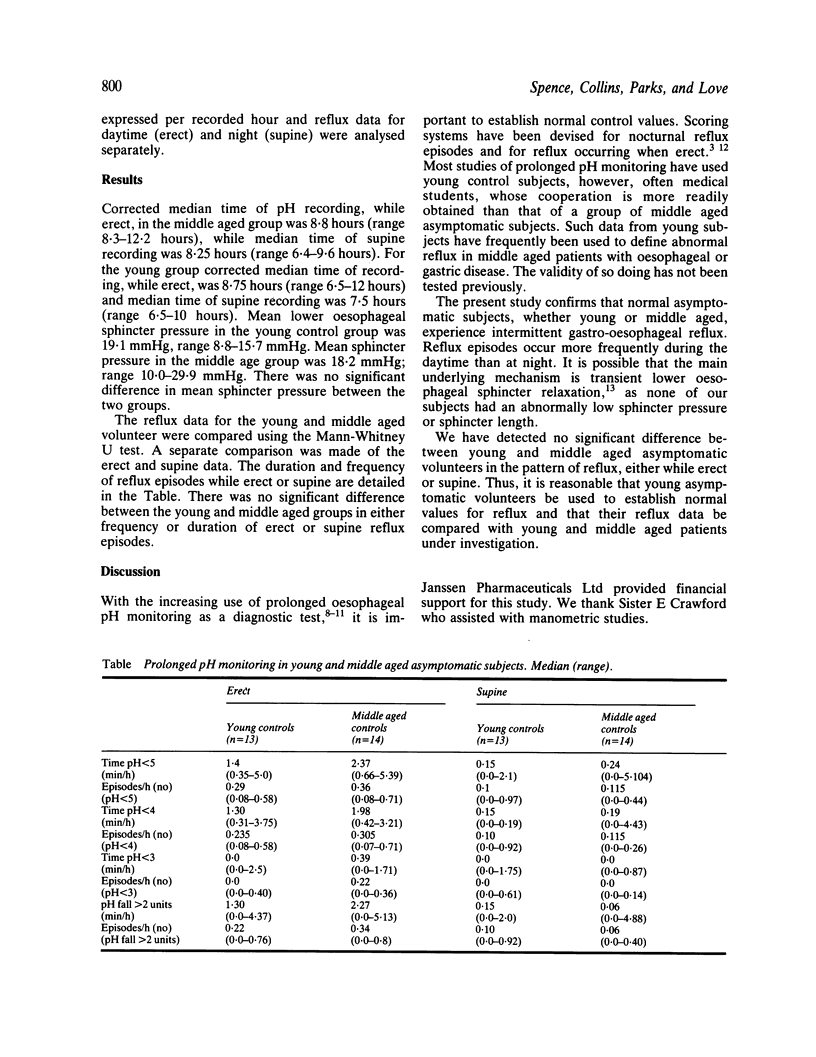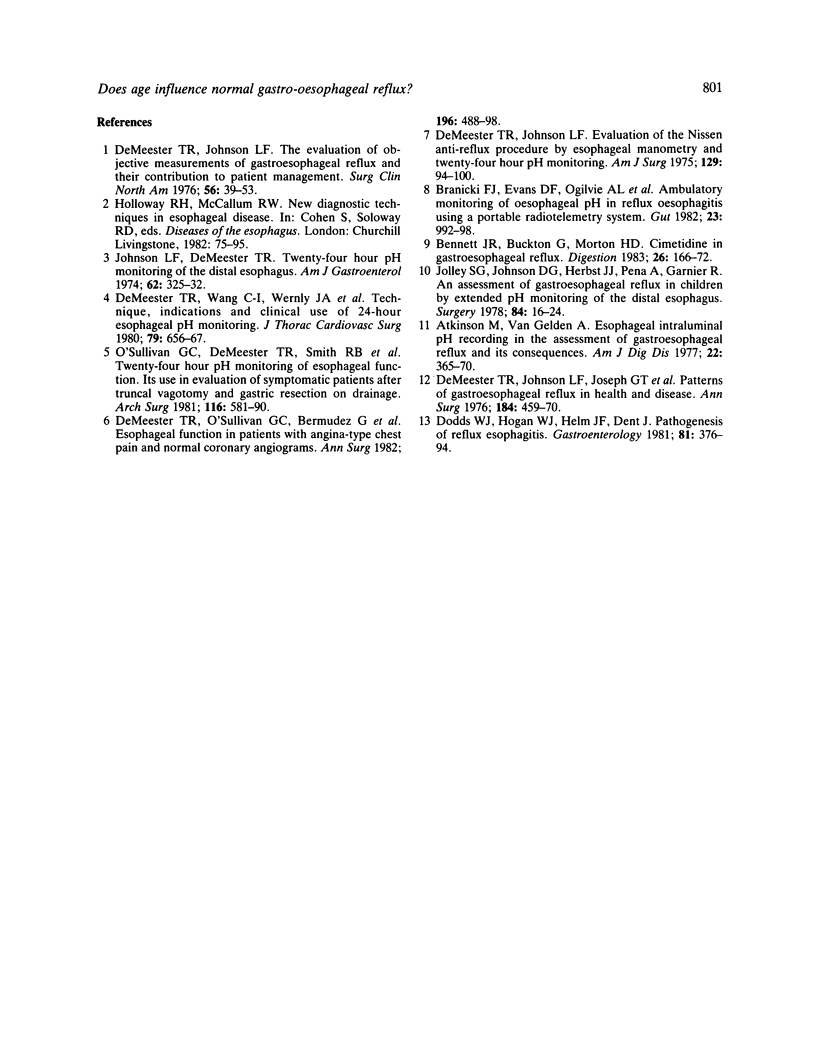Abstract
Prolonged oesophageal pH monitoring is being used increasingly to detect abnormal gastro-oesophageal reflux. To assess the influence of age on normal reflux patterns, a group of 13 young asymptomatic subjects (mean age 22 years) was compared with a group of 14 middle aged asymptomatic subjects (mean age 49 years). An ambulatory system using a radiotelemetry capsule and a portable receiving system was used, oesophageal pH being recorded for at least 16 hours during an overnight hospital stay under standardised conditions. There was no significant difference in the duration or frequency of reflux episodes as defined by pH less than 5, less than 4, less than 3, or as a fall in pH of more than two units. It is concluded that it is an acceptable practice to use young volunteers to establish normal values in reflux studies of young and middle aged patients.
Full text
PDF


Selected References
These references are in PubMed. This may not be the complete list of references from this article.
- Atkinson M., Van Gelder A. Esophageal intraluminal pH recording in the assessment of gastroesophageal reflux and its consequences. Am J Dig Dis. 1977 Apr;22(4):365–370. doi: 10.1007/BF01072195. [DOI] [PubMed] [Google Scholar]
- Bennett J. R., Buckton G., Martin H. D. Cimetidine in gastro-oesophageal reflux. Digestion. 1983;26(3):166–172. doi: 10.1159/000198884. [DOI] [PubMed] [Google Scholar]
- Branicki F. J., Evans D. F., Ogilvie A. L., Atkinson M., Hardcastle J. D. Ambulatory monitoring of oesophageal pH in reflux oesophagitis using a portable radiotelemetry system. Gut. 1982 Nov;23(11):992–998. doi: 10.1136/gut.23.11.992. [DOI] [PMC free article] [PubMed] [Google Scholar]
- DeMeester T. R., Johnson L. F. Evaluation of the Nissen antireflux procedure by esophageal manometry and twenty-four hour pH monitoring. Am J Surg. 1975 Jan;129(1):94–100. doi: 10.1016/0002-9610(75)90174-9. [DOI] [PubMed] [Google Scholar]
- DeMeester T. R., Johnson L. F. The evaluation of objective measurements of gastroesophageal reflux and their contribution to patient management. Surg Clin North Am. 1976 Feb;56(1):39–53. doi: 10.1016/s0039-6109(16)40834-0. [DOI] [PubMed] [Google Scholar]
- DeMeester T. R., O'Sullivan G. C., Bermudez G., Midell A. I., Cimochowski G. E., O'Drobinak J. Esophageal function in patients with angina-type chest pain and normal coronary angiograms. Ann Surg. 1982 Oct;196(4):488–498. doi: 10.1097/00000658-198210000-00013. [DOI] [PMC free article] [PubMed] [Google Scholar]
- DeMeester T. R., Wang C. I., Wernly J. A., Pellegrini C. A., Little A. G., Klementschitsch P., Bermudez G., Johnson L. F., Skinner D. B. Technique, indications, and clinical use of 24 hour esophageal pH monitoring. J Thorac Cardiovasc Surg. 1980 May;79(5):656–670. [PubMed] [Google Scholar]
- Demeester T. R., Johnson L. F., Joseph G. J., Toscano M. S., Hall A. W., Skinner D. B. Patterns of gastroesophageal reflux in health and disease. Ann Surg. 1976 Oct;184(4):459–470. doi: 10.1097/00000658-197610000-00009. [DOI] [PMC free article] [PubMed] [Google Scholar]
- Dodds W. J., Hogan W. J., Helm J. F., Dent J. Pathogenesis of reflux esophagitis. Gastroenterology. 1981 Aug;81(2):376–394. [PubMed] [Google Scholar]
- Johnson L. F., Demeester T. R. Twenty-four-hour pH monitoring of the distal esophagus. A quantitative measure of gastroesophageal reflux. Am J Gastroenterol. 1974 Oct;62(4):325–332. [PubMed] [Google Scholar]
- Jolley S. G., Johnson D. G., Herbst J. J., Pena A., Garnier R. An assessment of gastroesophageal reflux in children by extended pH monitoring of the distal esophagus. Surgery. 1978 Jul;84(1):16–24. [PubMed] [Google Scholar]
- O'Sullivan G. C., DeMeester T. R., Smith R. B., Ryan J. W., Johnson L. F., Skinner D. B. Twenty-four-hour pH monitoring of esophageal function. Its use in evaluation in symptomatic patients after truncal vagotomy and gastric resection or drainage. Arch Surg. 1981 May;116(5):581–590. doi: 10.1001/archsurg.1981.01380170061011. [DOI] [PubMed] [Google Scholar]


